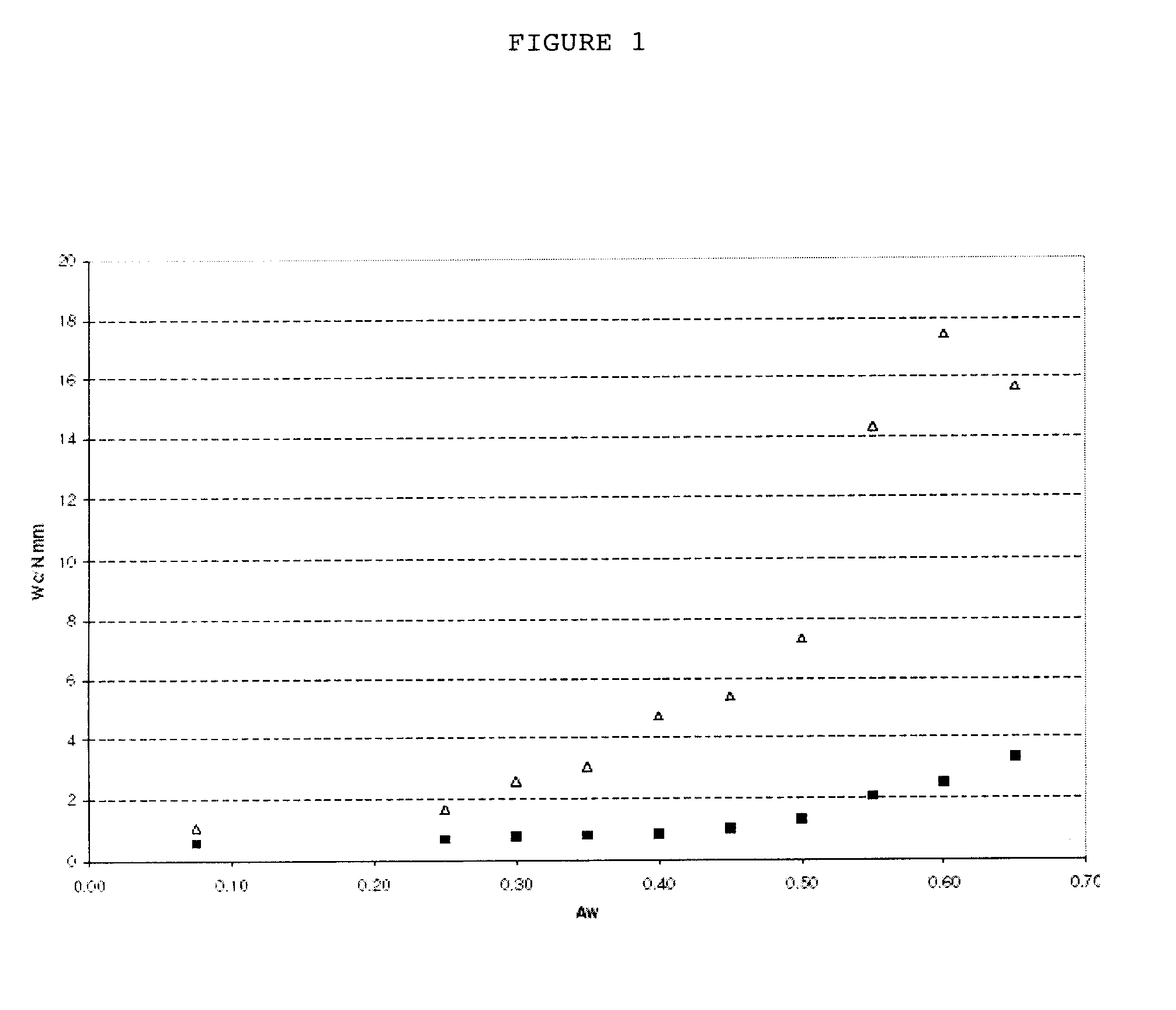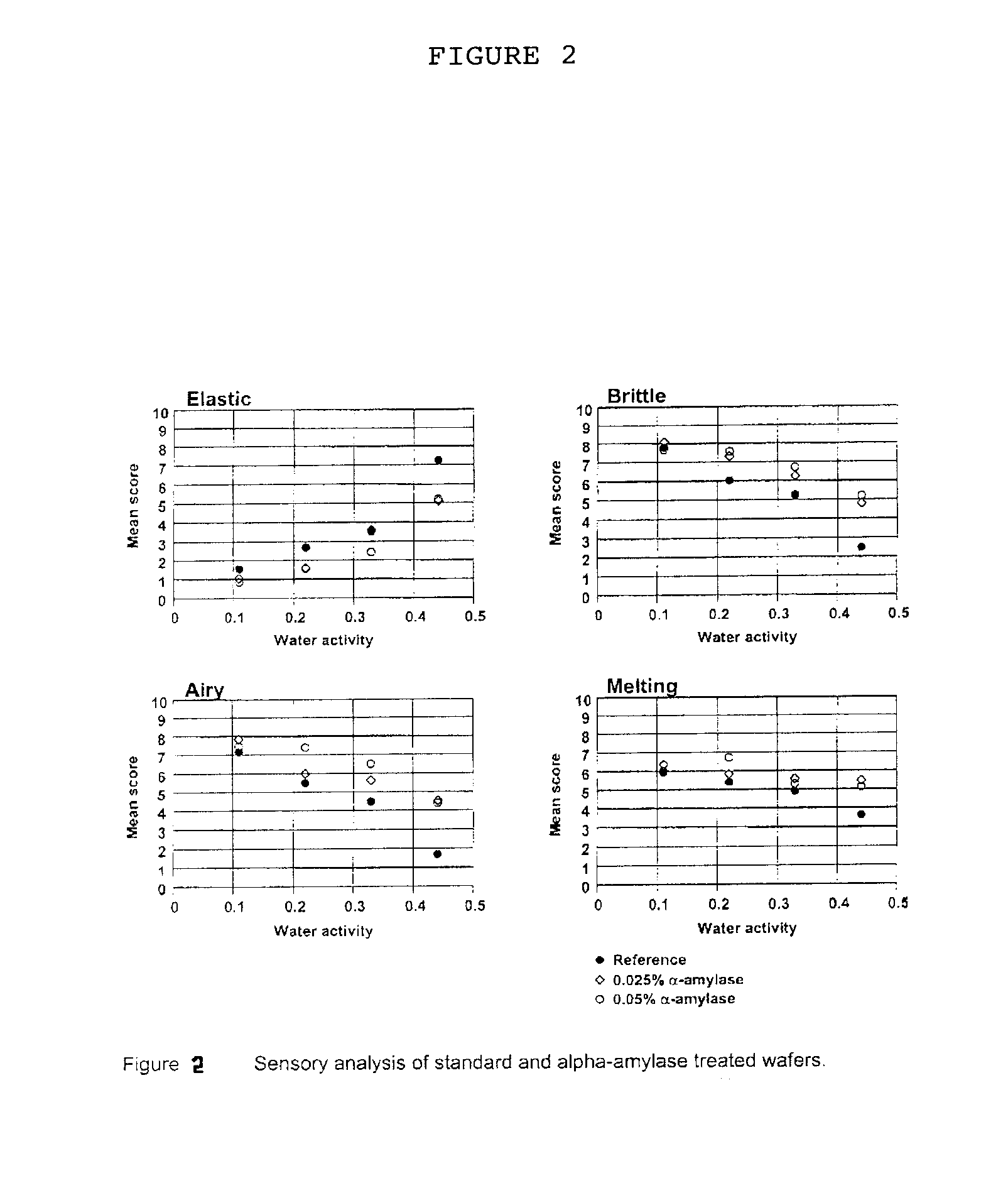Moisture resistant wafer
a technology of moisture resistance and wafer, which is applied in the field of moisture resistance or moisture tolerant wafer, can solve the problems of affecting the quality of wafers, and affecting the quality of wafers, and achieves the effect of high water activity
- Summary
- Abstract
- Description
- Claims
- Application Information
AI Technical Summary
Problems solved by technology
Method used
Image
Examples
example 1
Mechanical Assessment of Moisture Tolerance of Wafer
[0047]A batter was prepared having the following formulation:
Flour100.0partsWater160.0partsSucrose2.0partsFat1.0partsLecithin0.2partsSodium bicarbonate0.2parts
[0048]Two fractions of the batter were prepared. 0.1 part of a commercial alpha-amylase, Validase BAA from Valley Research containing 1,200,000 Modified Wohlgemuth Units (MVVU) per gram, was added to one of the fractions (treated fraction). The other fraction, without addition of alpha-amylase, was used as reference (standard fraction).
[0049]Wafers were prepared to provide two types of wafers: one series of reference wafers without enzyme (standard) and one series of wafers treated with the alpha-amylase (treated). Wafers were prepared by baking the batters for 2 minutes in an oven (25-plate wafer oven, Hebenstreit Moerfelded, West Germany) between two metal plates heated to 130° C. After short cooling, samples were hydrated in climatic chambers at the desired water activity ...
example 2
Sensory Evaluation of Wafers
[0056]A batter comprising 780 g of wheat flour, 730 g of water and minor ingredients was treated for 30 min at 35° C. with a commercial enzyme blend containing protease and xylanase to obtain a suitable viscosity. 2 g of sodium bicarbonate were added to the mixture. Three fractions of batter were prepared. A commercial alpha-amylase, Validase BAA from Valley Research containing 1,200,000 Modified Wohlgemuth Units (MVVU) per gram and having an optimum temperature of activity of 65° C.-75° C. and an effective temperature of activity of up to 90° C. was added to 2 fractions at a level of 0.25 and 0.5 g / kg batter respectively. The third fraction, without addition of alpha-amylase, was used as reference. Wafers were prepared by baking the batters 2 min in an oven (Hebenstreit ZQE Mini) between two metal plates heated to 160° C.
[0057]After short cooling, the wafers were either maintained in a sealed plastic bag (about 0.05 water activity) or equilibrated at 24°...
example 3
Sensory Evaluation of Mixes (Wafer-Caramel Cream)
[0067]Wafers were prepared according to the method described in Example 2 to provide two types of wafers: 1 series of reference wafers without enzyme and 1 series of wafers treated with alpha-amylase (0.5 g / kg batter). The wafers were cut into 3 cm diameter pieces (mean weight: 0.4 g) and allowed to equilibrate up to a constant weight for 3 weeks at 24° C. in a closed dessicator containing a saturated solution of magnesium chloride (relative humidity: 32.8%). Caramel cream (2.4 g; water activity 0.533) was layered between 2 wafer pieces and the resulting sandwiches were placed in small individual airtight jars. The jars were allowed to stand at 24° C. for 3 weeks in order to allow water to migrate from the cream to the wafers up to equilibrium (0.49 water activity).
[0068]Descriptive sensory data on texture were collected from a group of 6 of the trained panellists of Example 2. All assessors found a very significant difference between...
PUM
 Login to View More
Login to View More Abstract
Description
Claims
Application Information
 Login to View More
Login to View More - R&D
- Intellectual Property
- Life Sciences
- Materials
- Tech Scout
- Unparalleled Data Quality
- Higher Quality Content
- 60% Fewer Hallucinations
Browse by: Latest US Patents, China's latest patents, Technical Efficacy Thesaurus, Application Domain, Technology Topic, Popular Technical Reports.
© 2025 PatSnap. All rights reserved.Legal|Privacy policy|Modern Slavery Act Transparency Statement|Sitemap|About US| Contact US: help@patsnap.com



